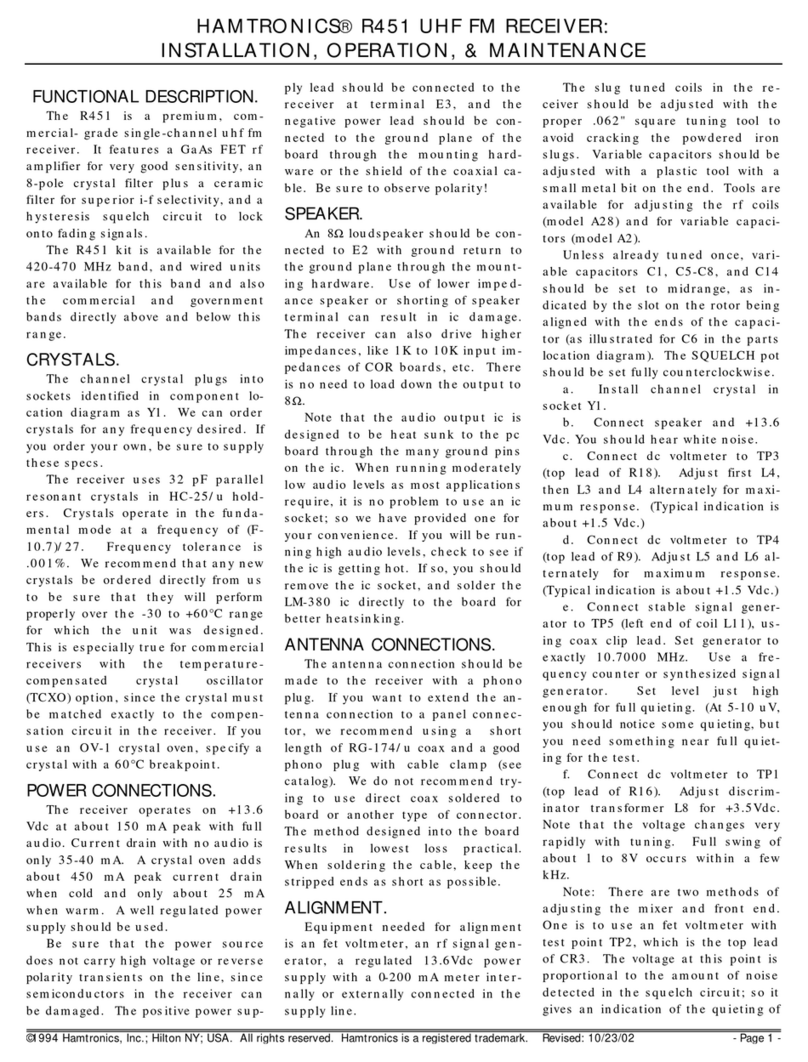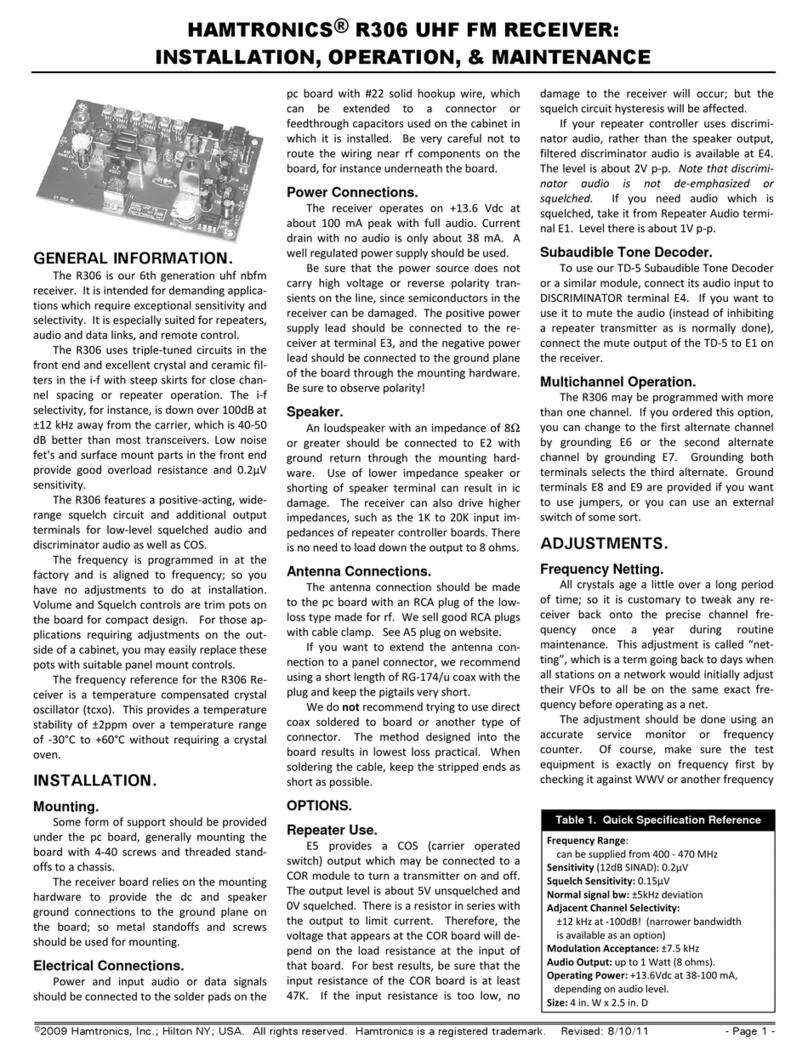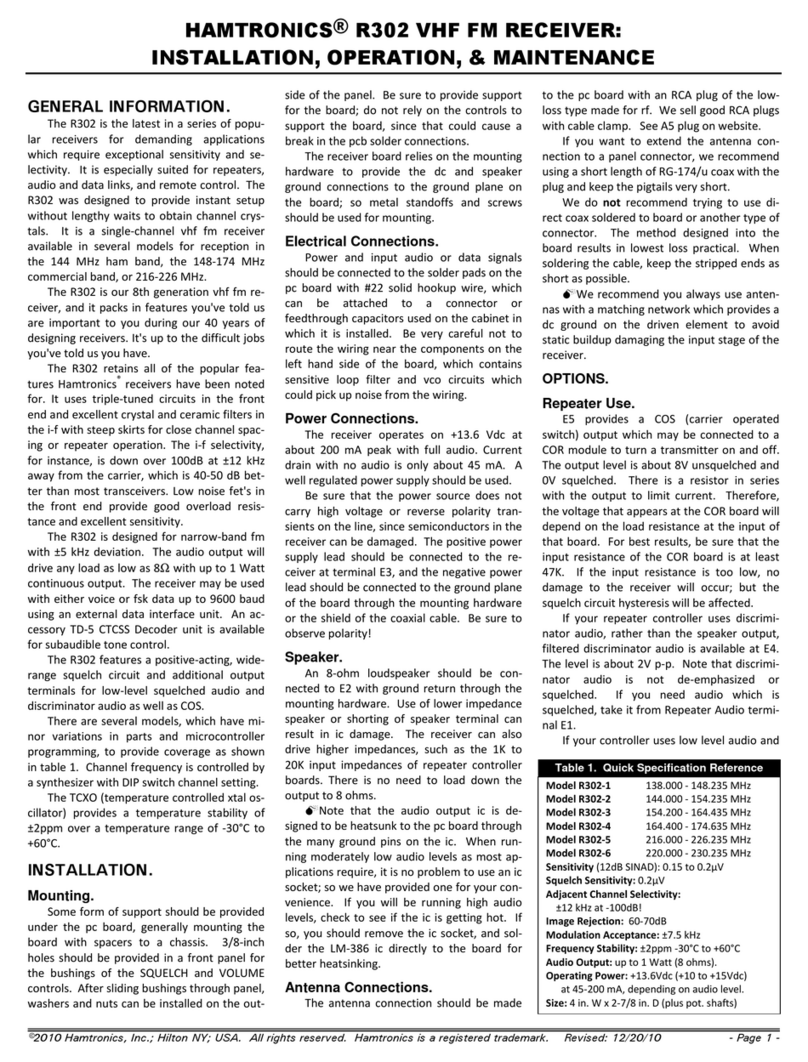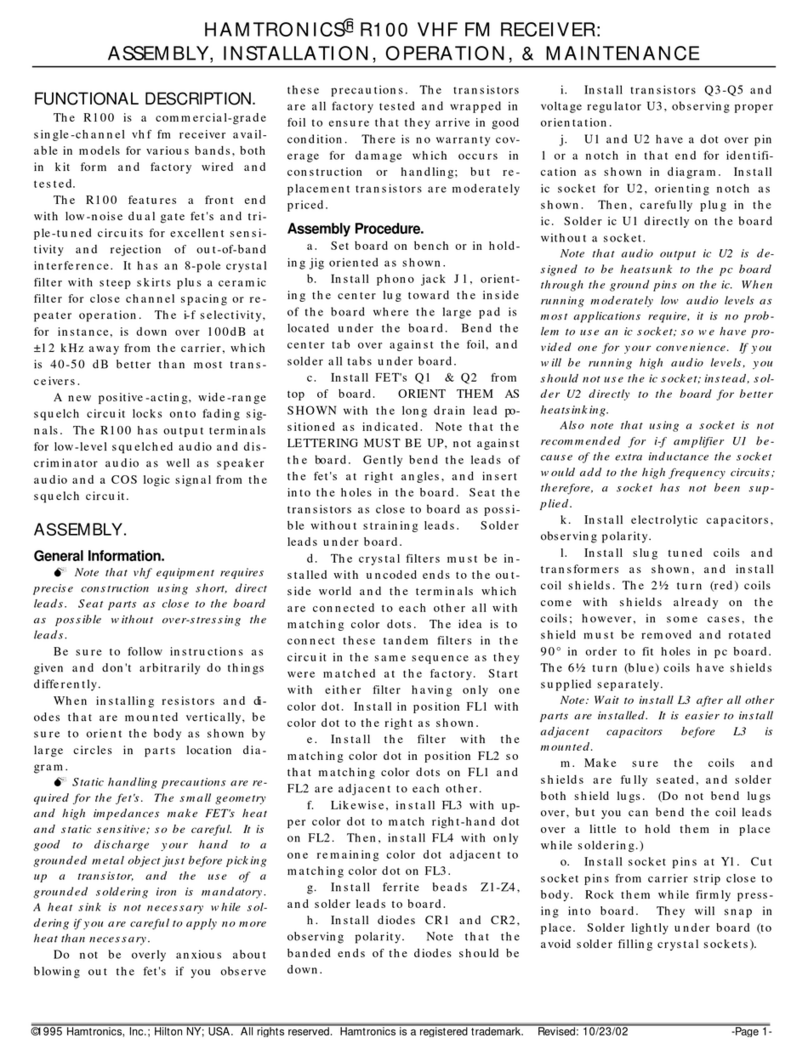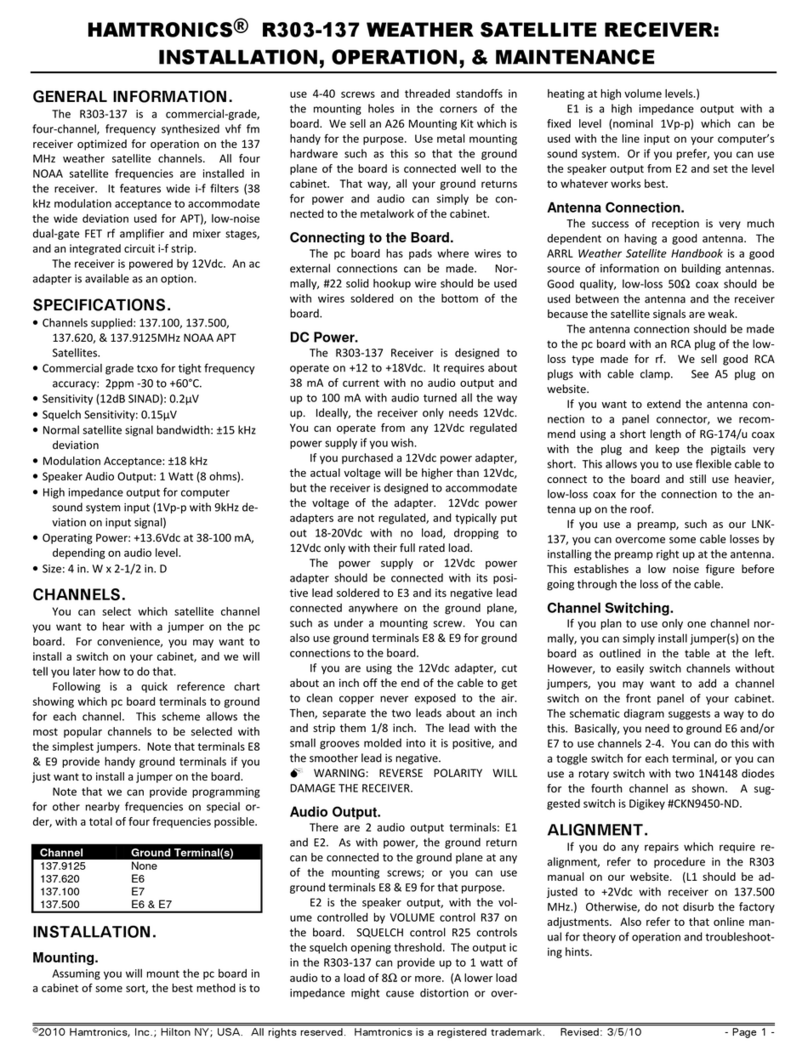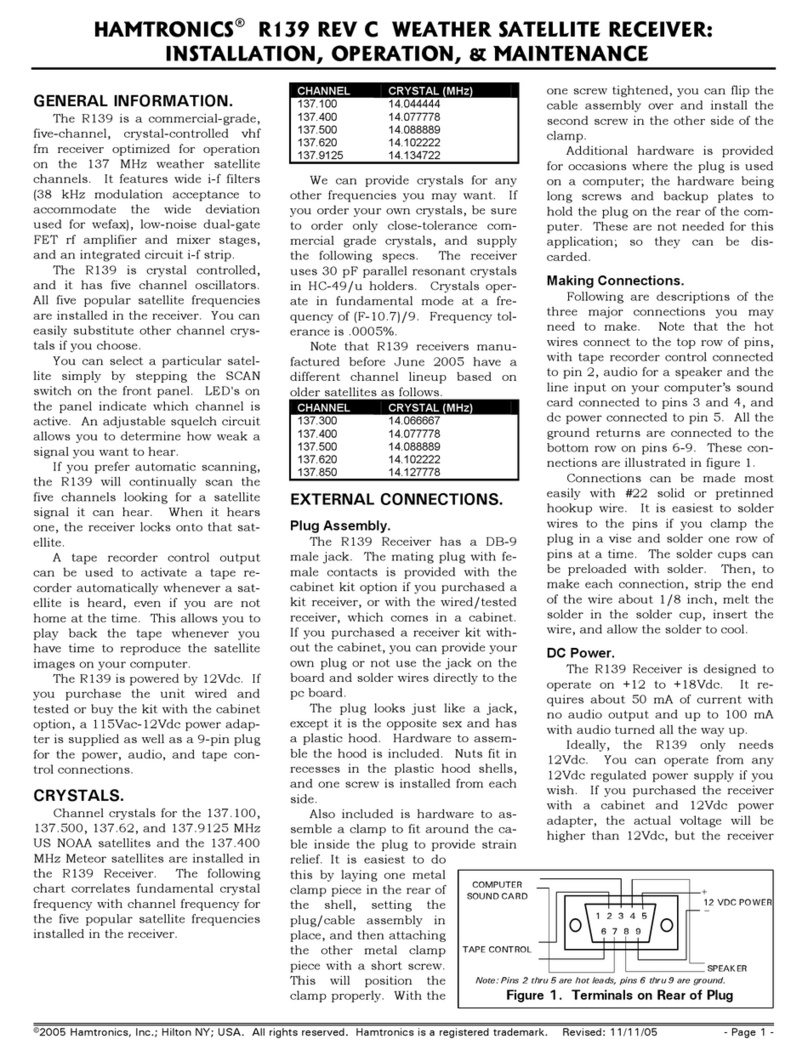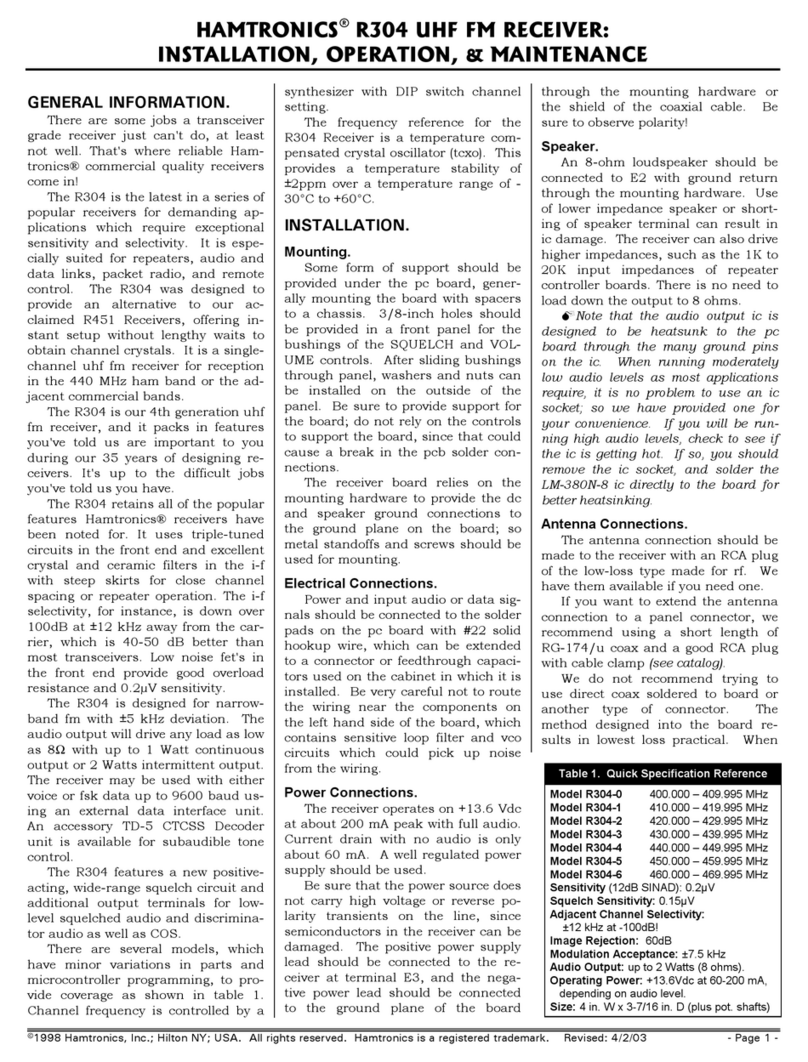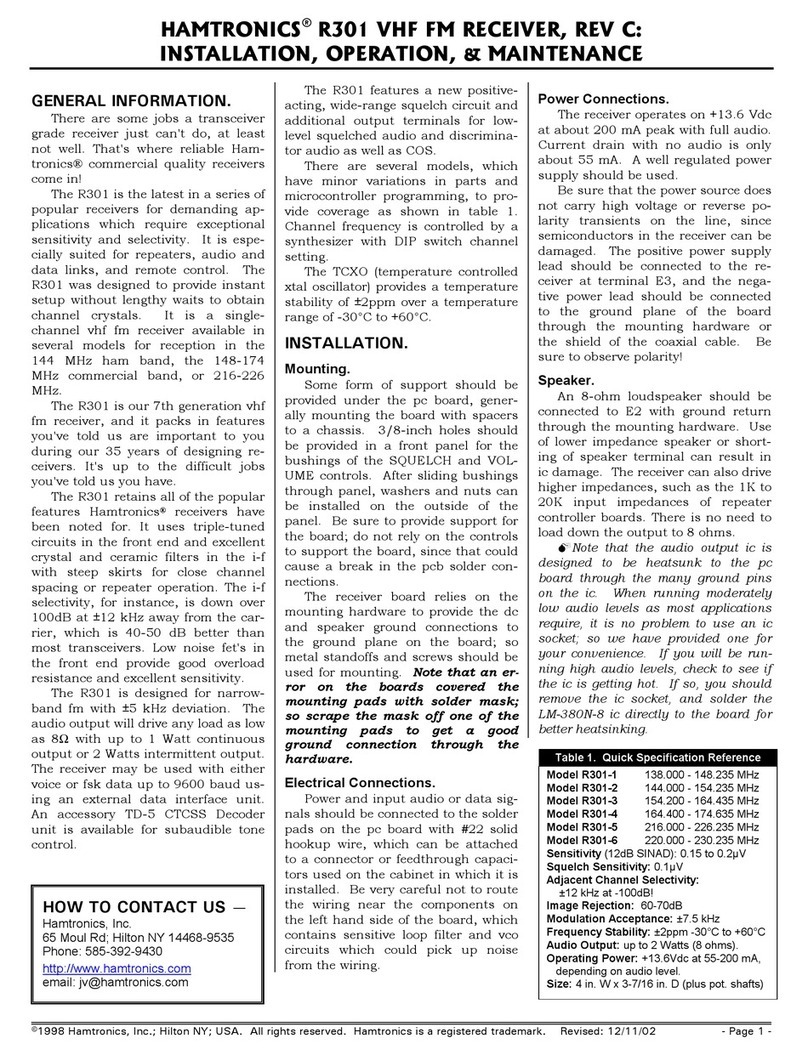
©1994 Hamtronics, Inc.; Hilto
n NY; USA. All rights reserved. Hamtronics is a registered trademark. evised:
still on 10.7000 MHz. With weak sig-
nal applied to Q2 gate-1 as before, ad-
just L2 for minimum noise or
distortion. This step is critical to get
lowest distortion in the crystal filter.
h. Remove signal generator so the
receiver hears just noise. Readjust L8
slightly so that the voltage at TP1 is
+3.5V with just noise coming through
the i-f.
i. Connect signal generator to J1.
Adjust to exact channel frequency,
and turn output level up fairly high.
Adjust frequency trimmer capacitor
C16 to net the crystal to channel fre-
quency, indicated by +3.5Vdc at test
point TP1. If you can't find the signal
at all, tune your signal generator up
and down the band slightly. (Also
check that oscillator is peaked as per
step c.)
If your crystal has the wrong load
correlation or is slightly out of toler-
ance, you may be able to compensate
by changing the value of C15 so C16
can net the crystal on frequency. The
piston capacitor tuning range is re-
stricted to achieve best frequency sta-
bility; so sometimes it may be
necessary to change the fixed ca-
pacitor. The proper adjustment re-
sults in +3.5Vdc, the same as preset
for the exact 10.700 MHz i-f frequency
earlier.
Maximum capacitance (lowest fre-
quency) occurs with the piston
screwed in all the way, and minimum
capacitance (highest frequency) is
with the piston all the way up. Be
careful not to completely remove the
piston. If the piston screw becomes a
little tight (squeaky), you can apply a
small amount of silicone oil to the
threads.
j. Connect fet dc voltmeter to TP2
(top lead of CR3). Set signal generator
for relatively weak signal, one which
shows some change in the dc voltage
indication at TP2. Alternately peak
C14, C8, C7, C6, C5, and C2 until no
further improvement can be made.
On C8, you may get two peaks over
180° rotation: a peak at the injection
frequency and a peak at the signal
frequency. The correct peak is at the
injection frequency, which occurs at
the setting of greater capacitance (to-
ward flat end of C8). Note that the
tuning of input variable capacitor C2
normally is very broad.
When properly tuned, sensitivity
should be about 0.2µV for 12 dB
SINAD.
SQUELCH CIRCUIT.
The squelch circuit has about 3 to
6 dB of hysteresis built in, so that
once the squelch opens, the signal
must drop 3 to 6 dB below the open-
ing threshold before squelching again.
This allows for some fading on mobile
stations and prevents squelch pump-
ing on heavy modulation. It also pre-
vents cycling due to slight desense in
repeater installations. Of course, this
requires setting the threshold a little
higher than if there was no hysteresis
so that it will close with no signal. If
you prefer the older type squelch, you
can simply remove Q5 from the cir-
cuit; however, this is not recom-
mended for repeater installations. If
you want more or less hysteresis, you
can decrease or increase the value of
R25.
REPEATER USE.
4 provides a "carrier operated
switch" output which may be con-
nected to a COR module to turn a
transmitter on and off. The output
level is about 7V unsquelched and 0V
squelched. There is a resistor in se-
ries with the output to limit current.
Refer to COR module instructions for
details.
If your repeater controller uses dis-
criminator audio, rather than the
speaker output, filtered discriminator
audio is available at 5. The level is
about 2V p-p. If you need audio
which is squelched, take it from the
input (right hand) terminal on the
VOLUM control.
AUDIO MUTING.
If the receiver is used as a part of a
transceiver, audio muting can be ac-
complished without switching the
power or speaker lines. If the trans-
mitter is keyed by applying B+ to the
exciter, simply connect the keyed B+
through a 100K resistor to the junc-
tion of R25 and R27 on the receiver
board. The dc level will be sufficient
to trigger the squelch circuit in U2,
regardless of the rf signal level coming
into the receiver.
Of course, some means of discon-
necting the receiver from the antenna
must be provided, and we recommend
our TRR Coax Relay Module if the
power level is under 25 Watts. Other-
wise, a larger coax relay will be re-
quired.
DISCRIMINATOR METER.
If you wish to use a discriminator
meter and you are handy in designing
with op-amps, you can run a sample
of the dc voltage at DISCRIMINATOR
output terminal 5 to one input of an
op-amp and tie the other input to a
voltage divider pot set to provide a ref-
erence voltage of about +3.5Vdc.
S-METER.
There is no s-meter function, as
such, available in if amplifier ic's
made for professional receivers; how-
ever, a signal strength indication is
available at test point TP2. This volt-
age is a function of the noise level de-
tected in the squelch circuit. It is
about +3Vdc with no signal and 0Vdc
with full quieting. You can tap off this
point with a high-impedance circuit,
such as an op-amp, to drive a meter
or a computerized repeater controller.
SUBAUDIBLE TONE
DECODER.
To use our TD3 Subaudible Tone
Decoder or a similar module, connect
its audio input to DISCRIMINATOR
terminal 5. If you want to use it to
mute the audio (instead of inhibiting a
repeater transmitter as is normally
done), connect the mute output of the
TD-3 to the right-hand lug of the vol-
ume control.
MOUNTING.
Some form of support should be
provided under the pc board, gener-
ally mounting the board with spacers
to a chassis. 3/8-inch holes should
be provided in a front panel for the
bushings of the SQU LCH and VOL-
UM controls. After sliding bushings
through panel, washers and nuts can
be installed on the outside of the
panel. Be sure to provide support for
the board; do not rely on the controls
to support the board.
For repeater applications, the re-
ceiver should be mounted in an rf
tight box, such as our model A16.
The receiver board relies on the
mounting hardware to provide the dc
and speaker ground connections to
the ground plane on the board.
TROUBLESHOOTING.
The usual troubleshooting tech-
niques of checking dc voltages and
signal tracing work well in trou-
bleshooting the receiver. A dc voltage
chart and a list of typical audio levels
are given to act as a guide to trou-
bleshooting. Although voltages may
vary widely from set to set and under
various operating and measurement
conditions, the indications may be
helpful when used in a logical trou-
bleshooting procedure.
The most common troubles in all
kits are interchanged components,
